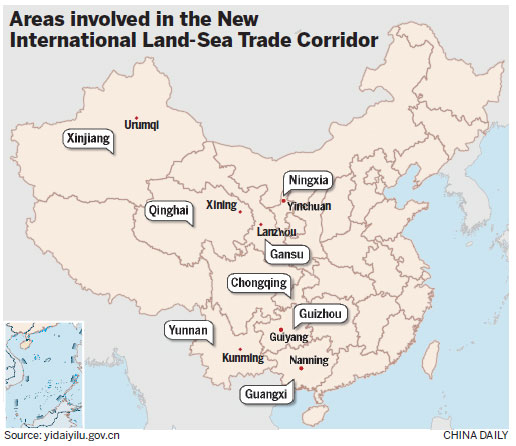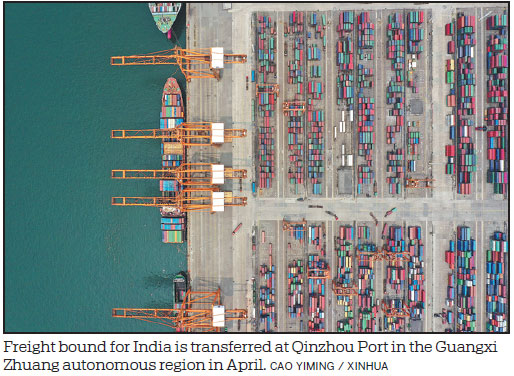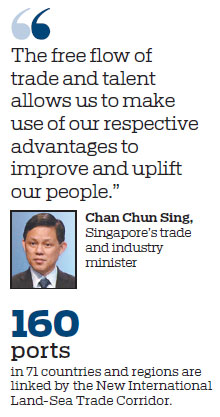
It's the fastest route connecting China's inland western region with major ports in South China as well as ASEAN members and countries participating in BRI
A railway line that connects Lanzhou, Northwest China's Gansu province, with Chongqing, the biggest city in Southwest China, has removed a bottleneck in building a trade corridor that links China and Singapore, and is also a key link in China's Belt and Road Initiative.
The line, some 700 kilometers shorter than the old rail line, was officially opened on Sept 29, 2017.


"It takes six days - half the time taken earlier - for goods from Lanzhou to reach Ho Chi Minh City, Vietnam, via Qinzhou port in the Guangxi Zhuang autonomous region," said Cao Zhu, general manager of Lanzhou International Port Multimodal Transport Co, a company that deals with international trade, concentrated transport and storage service. "It reduces a lot of costs for businesses."
The New International Land-Sea Trade Corridor has turned out to be the fastest route that connects China's inland western region with major ports in South China.
The corridor is jointly built by western Chinese provinces and countries of the Association of Southeast Asian Nations, or ASEAN, under the framework of the China-Singapore (Chongqing) Demonstration Initiative on Strategic Connectivity, which the two sides signed in 2016. The initiative is expected to serve as a base for opening up inland Chongqing and better cooperation between China and Singapore.
It links 160 ports in 71 countries and regions worldwide, as part of China's Silk Road Economic Belt and the 21st-Century Maritime Silk Road - the BRI, said Han Baochang, director of demonstration initiative's administration committee.
At a forum on the new trade route held in Chongqing on Jan 8, Singapore's Trade and Industry Minister Chan Chun Sing said the corridor opens up tremendous opportunities for new products, including perishable goods. It works best as an open and inclusive network.
The new trade route is a network of railways, roads and air freight, with Chongqing as the transportation hub. In the south, it runs from western China to Qinzhou port, which further connects to Southeast Asia via sea. In the north, it links the China-Europe freight trains launched from many western Chinese cities before they head to Central Asia and Europe.
The China-Europe rail freight service, a crucial part of the BRI, connects 59 Chinese cities with 49 cities in 15 European countries. In 2018, the trains made a total number of 6,363 trips, a 72 percent rise over the previous year, according to China Railway Corporation.
Trains head to Europe with garments, auto parts, chemicals and other Chinese goods, and return with European food, machinery, equipment and timber.
Han said by the end of 2018, freight trains had made 805 trips through the corridor since a faster transit service combining rail lines and sea routes was launched in September 2017.
One Chinese municipality and seven Chinese provinces and autonomous regions have officially joined the network. These include Chongqing, Guangxi, Guizhou, Gansu, Qinghai, Xinjiang, Yunnan and Ningxia.
"The free flow of trade and talent allows us to make use of our respective advantages to improve and uplift our people," said Singapore's trade and industry minister.

Han called the corridor "a strategic passage of great economic significance". It helps China's western region come together for cooperation.
During his visit to Guangxi in April 2017, President Xi Jinping asked the region to make full use of its geographic location and the potential of coastlines, rivers and border areas to promote opening-up. He urged it to capitalize on its advantages and play a bigger role in the BRI.
Guangxi adjoins Guangdong province and borders Vietnam.
The Beibu Gulf Economic Zone, which was established in 2006 and includes six cities of Nanning, Beihai, Qinzhou, Fangchenggang, Yulin and Chongzuo, has become increasingly important in connecting southwest and central China with Southeast Asian nations, said Huang Jian, a counselor for Guangxi government.
In its draft plan on the national economic and social development in 2019, the State Council, China's Cabinet, announced the country will push for 70 infrastructure projects, including the land-sea corridor.
During their meeting in September 2017, President Xi and Singaporean Prime Minister Lee Hsien Loong highlighted the potential of the trade corridor and the China-Singapore (Chongqing) Demonstration Initiative on Strategic Connectivity in playing an important role in supporting the BRI as well as China's domestic development priorities, particularly in western China.
In April 2018, the two countries inked a deal that paved the way for a closer partnership between their companies in other countries involved in the BRI.
For a sustainable future, the corridor should be developed in a way that all parties' interests are taken into consideration, said Yang Xiangzhang and Zheng Yongnian, research fellows at the Center for China's Neighbor Diplomacy of Yunnan University.
Hao Jie and Li Dawei, researchers at the Research Institute of Foreign Trade and Economic Cooperation in Beijing, said there is still room for improving transportation on the corridor.
They suggested that efficient transportation networks such as air cargo and high-speed rails be upgraded for the corridor.
Contact the writers at caihong@chinadaily.com.cn